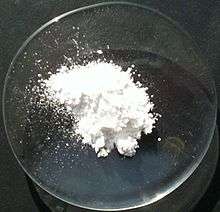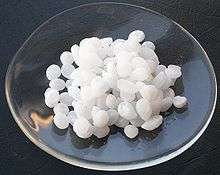Basic oxide
Basic oxides are oxides that show basic properties in opposition to acidic oxides and that either
- reacts with water to form a base; or
- reacts with an acid to form a salt and water which called neutralization reactions.
Etymology
"Basic oxides" is a compounds word of "Basic" and "oxides". The word oxides referred to the chemical compounds that one or more oxygen atoms combined with another element such as H2O or CO2. Based on their acid-base characteristics oxides can be classified into four categories: acidic oxides, basic oxides, and amphoteric oxides and neutral oxides.
Basic oxides, can also called base anhydrides which means "a base without water", are usually formed by reacting of oxygen with metals, especially alkali (+1 oxidation state) and alkaline earth metals (+2 oxidation state). Both of them are ionic oxide and can dissolve in water to form basic solutions of the metal hydroxide, whereas non-metals usually form acidic oxides. Basic oxide Li2O becomes base LiOH and BaO becomes Ba(OH)2 after react with water. In general, basicity of their oxides increases when the elements located downward at the left side of a periodic table (group 1 & 2), as the element become more metallic.[1]
Alkali Metals (Group 1)
- X2O + H2O → 2XOH (X means group 1)
Alkaline Earth Metals (Group 2)
- XO + H2O → X(OH)2 (X means group 2)
Examples include:
- Sodium oxide, which reacts with water to produce sodium hydroxide
- Magnesium oxide, which reacts with hydrochloric acid to form magnesium chloride
- Copper(II) oxide, which reacts with nitric acid to form copper nitrate
Formation
Examples of Oxides (Group 1 elements react with oxygen):
- Lithium reacts with oxygen to give oxide. Li2O
4 Li(s) + O2(g) → 2 Li2O(s)
- Sodium reacts with oxygen to give peroxide. Na2O2
2 Na(s) + O2(g) → Na2O2(s)
- Potassium reacts with oxygen to form superoxide. KO2
K(s) + O2(g) → KO2(s)
Properties
The molecules that contain the group of H-O-X can behave normally as acids but when the hydroxide ion is produced they can behave as bases.[2] The O-X bond will remain intact and become polar and the weak O-H bond will tend to break, releasing a proton when the H-O-X grouping is dissolved in water. The O-X bond will become ionic and breakdown in polar water if X has very low electronegativity. For example, when NaOH and KOH which are ionic substances dissolve in water they will produce basic solutions of the metal cation and hydroxide ion.[3] These principles can explain the base behavior when they are dissolved in water by recognizing that the oxide ion has a high affinity for protons. Most basic oxides are ionic in nature base on the difference of electronegativity of oxygen and metals. Dissolving basic oxide in water can increase pH (basicity) of water because basic oxides release hydroxide ions (OH−) to the water.
Examples
- All oxides in Group 1 & 2 elements are basic (except BeO), they react with water to form a base:[4]
- Lithium oxide reacts with water to produce Lithium hydroxide: Li2O(s) + H2O(l) → 2 Li+(aq) + 2 OH−(aq)
- Sodium oxide reacts with water to produce Sodium hydroxide: Na2O(s) + H2O(l) → 2 NaOH(aq)
- Potassium oxide reacts with water to produce Potassium hydroxide: K2O(s) + H2O(l) → 2 KOH(aq)
- Rubidium oxide reacts with water to produce Rubidium hydroxide: Rb2O(s) + H2O(l) → 2 RbOH(aq)
- Caesium oxide reacts with water to produce Caesium hydroxide: Cs2O(s) + H2O(l) → 2 CsOH(aq)
- Magnesium oxide reacts with water to produce Magnesium hydroxide: MgO(s) + H2O(l) → Mg(OH)2(aq)
- Calcium oxide reacts with water to produce Calcium hydroxide: CaO(s) + H2O(l) → Ca(OH)2(aq)
- Strontium oxide reacts with water to produce Strontium hydroxide: SrO(s) + H2O(l) → Sr(OH)2(aq)
- Barium oxide reacts with water to produce Barium hydroxide: BaO(aq) + H2O(l) → Ba(OH)2(aq)
- Some oxide in Group 13 element is basic, it reacts with water to form a base:
- Thallium(I) oxide reacts with water to produce Thallium(I) hydroxide: Tl2O(s) + H2O(l) → 2 TlOH(aq)
- Some oxide in Group 15 element is basic, it reacts with water to form a base:
- Bismuth(III) Oxide reacts with water to produce Bismuth(III) hydroxide: Bi2O3(s) + 3H2O(l) → 2 Bi(OH)3(aq)
- In neutralization reactions, basic oxides reacts with an acid to form salt and water:
- Magnesium oxide reacts with hydrogen chloride (acid) to produce Magnesium chloride (salt) and water: MgO + 2 HCl → MgCl2 + H2O
- Sodium oxide react with hydrogen chloride (acid) to produce Sodium chloride (salt) and water: Na2O + 2HCl → 2NaCl + H2O
- Sodium hydroxide react with hydrogen chloride (acid) to produce Sodium chloride (salt) and water: NaOH + HCl → NaCl + H2O
 Magnesium oxide
Magnesium oxide- Calcium oxide
 Sodium hydroxide
Sodium hydroxide
References
- Dr.Verma, Khanna, Dr.Kapila (2017). Comprehensive Chemistry XI. Laxmi Publications. p. 164.CS1 maint: multiple names: authors list (link)
- Zumdahl (2019). Chemistry 10e. Cengage Learning. p. 589.
- Zumdahl, Steven S. "Oxide". Britannica.
- Atkins, P.; Overton, T.; Rourke, J.; Weller, M.; Armstrong, F. (2006). Inorganic Chemistry. Oxford University Press. pp. 263–278.CS1 maint: multiple names: authors list (link)
